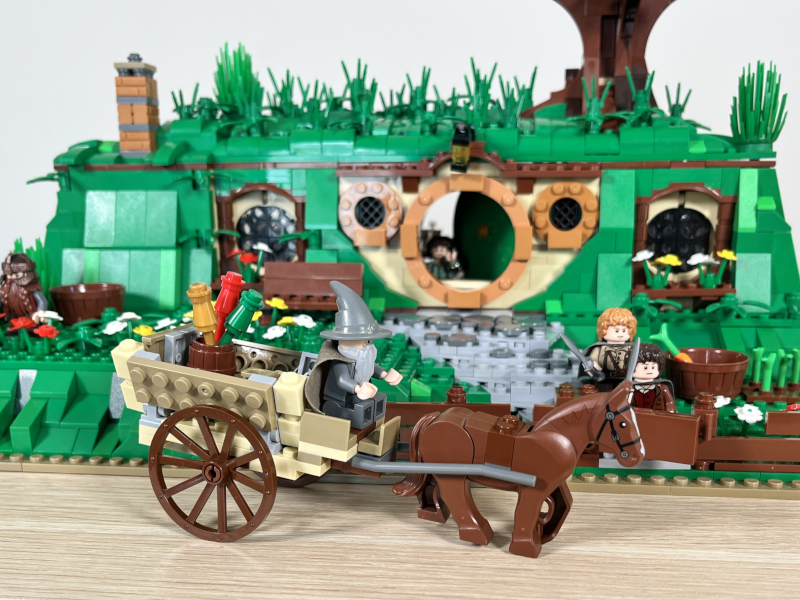
REVIEW – “In a hole in the ground there lived a hobbit. Not a nasty, dirty, wet hole, filled with the ends of worms and an oozy smell, nor yet a dry, bare, sandy hole with nothing in it to sit down on or to eat: it was a hobbit-hole, and that means comfort.” Thus begins one my of favorite stories of all time, The Hobbit by JRR Tolkien. This particular hobbit-hole is one of the most iconic locations in Middle Earth, Bilbo Baggins’ home, known as Bag End. In this review, I hope the Bag End set from Webrick will bring his domicile to life.
What is it?
Bag End is a LEGO-compatible building block set that features a recreation of Bilbo’s famous underground home in Hobbiton. Outside are plenty of flowers and plants, and inside are his most famous rooms, including a pantry and a dining room. This set has 2370 common pieces, mostly in shades of green, brown, tan, and grey, and includes many interior house parts, like food and dishes. Webrick’s mission is to “make every MOCer’s dream a reality.”
What’s in the box?
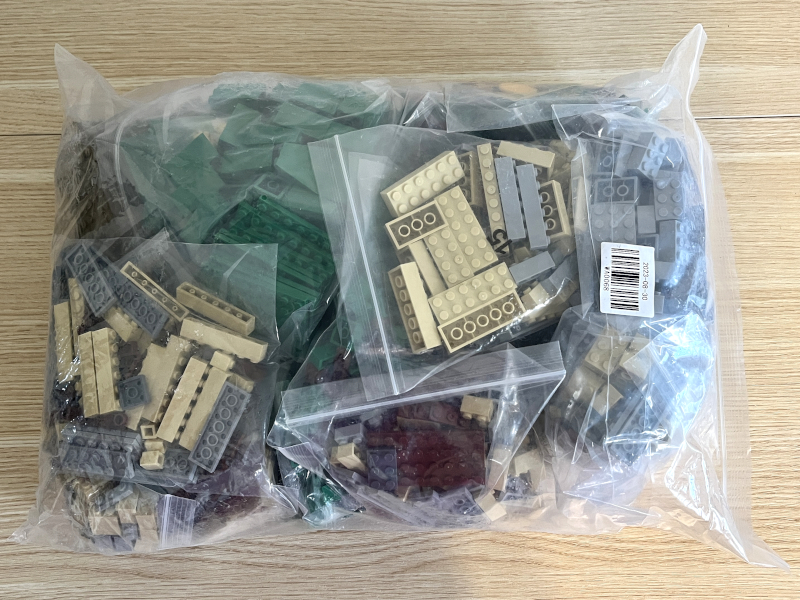
Actually, there’s not a box. Let me back up and explain what kind of company Webrick is. If you want a cool set to build, you can either buy something direct from LEGO, or you can save some money and buy from an off-brand like JMBricklayer or Funwhole.
But what if you find some instructions online that someone else created, and you want to try building that set? Or what if you have an idea on how to design your own set? Maybe you already have the bricks for these, but what if you don’t? That’s where Webrick comes in. Their website has tools that allow you to upload a list of bricks that you want, and they’ll let you know which ones they have. You can then buy them and build the set. These kinds of sets are known as MOC sets, which stands for Make your Own Creation. Anyone can make a MOC.
Webrick has a couple other features on their site, known as MOC builds and MOC sets. These are custom-designed creations made by individuals and designers. In Webrick’s words, “A MOC build refers to the digital or physical instructions for creating a custom LEGO model or creation. It may include step-by-step building instructions [and] parts lists. Builders use these instructions to source the necessary LEGO bricks and build the creation themselves. MOC Sets refer to custom LEGO creations that are not official LEGO products but are designed to be assembled and sold as complete sets. These sets are often designed by independent LEGO enthusiasts or AFOLs (Adult Fans of LEGO). MOC Sets are typically sold as complete packages, including all the required LEGO elements and instructions.”
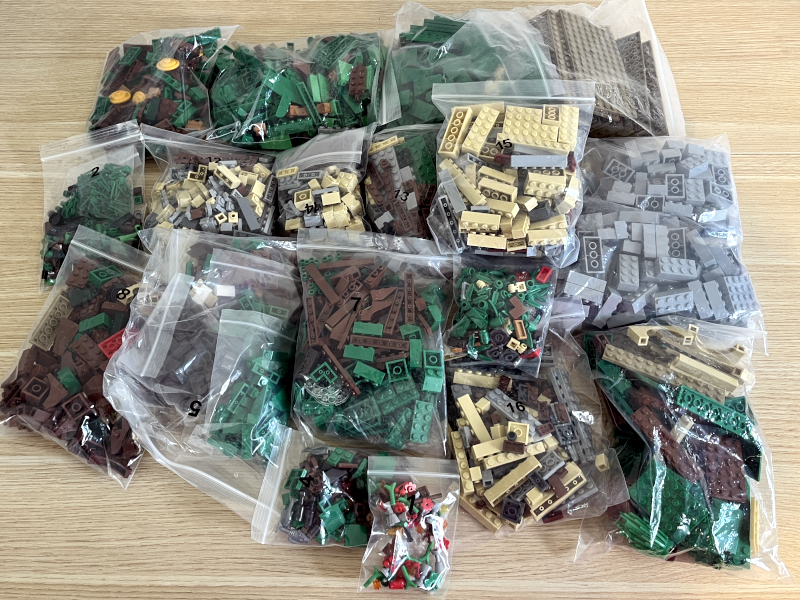
Bag End is a MOC set from Webrick. It’s missing the box on purpose, as Webrick informed me, “The absence of a box is to save on shipping costs and pass the savings on to our customers.” When it arrived, there was nothing to indicate what set it was, not even a packing slip, and there were no instructions. When you purchase a MOC set, Webrick provides a URL where you can download the instructions in PDF format.
To be clear: Even though some of my pictures depict mini figures and a horse, there are NO mini figs or horses included in this set! I already owned these mini figs from previous sets that I had purchased.
Design

Bag End is an expansion of two older set from LEGO. The first is An Unexpected Gathering, an underwhelming set that builds Bag End as two-room hobbit hole; the other is Gandalf Arrives, a cute little set that has Gandalf riding into town on a cart laden with fireworks. The designer of Bag End, who goes by the handle LegoMocLoc, has taken the basic pattern of An Unexpected Gathering and faithfully expanded it into a much larger hobbit-hole. Bilbo’s upgraded house now features a kitchen, an entryway, a bedroom, a pantry, and a dining room large enough for 13 dwarves. It also has a larger garden, more flowers, a longer set of steps to the front door, and more vegetation and a larger tree on the roof. It’s a big improvement, and it’s well done.
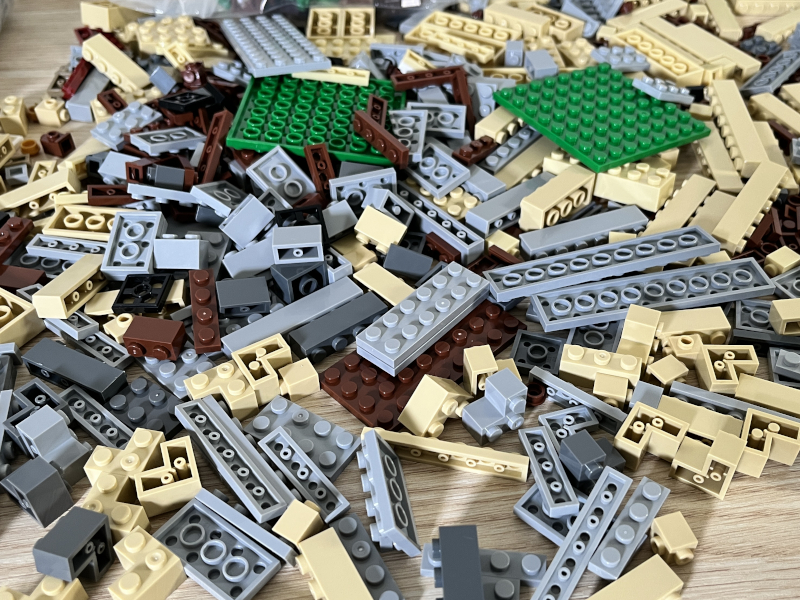
Are the bricks compatible with LEGO? Yes, these bricks are completely compatible with standard LEGO bricks.
Are they of the same build quality? Almost, but not quite. Most of these bricks are very close to LEGO’s bricks, but there are exceptions. The biggest problem was the large flat pieces that are used for the base; about half of them were significantly warped and never remained flat on the desk. As they were eventually covered with other pieces, this wasn’t a problem for the final build. The little flowers also had a problem, as many of the peddles didn’t snug up on the stems. Despite these issues, I am happy with these bricks.
This set is primarily made of basic pieces; there few Technic or other specialty pieces, other than the various interior accessories, like the food and dishes. This means that this set has a high re-use value, especially for younger builders. The colors work well for building anything in an outdoor setting, like a building or a landscape.
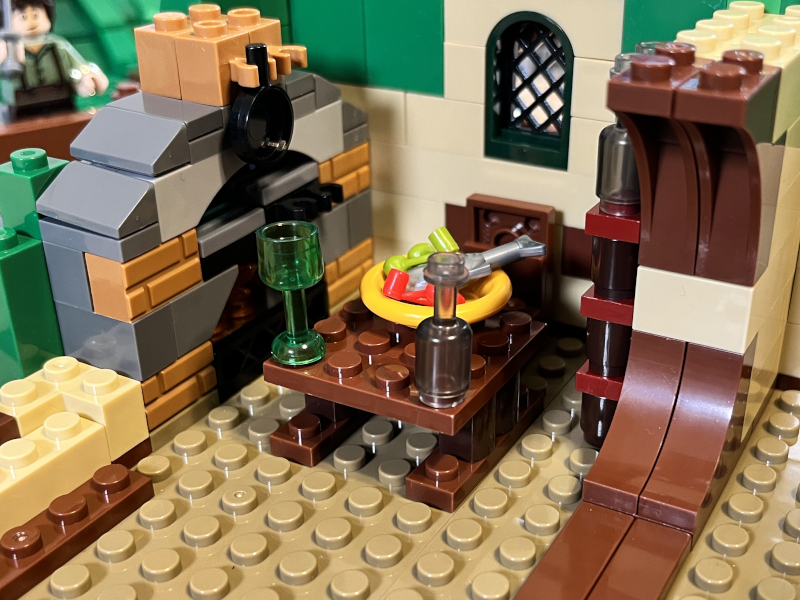
Do they fit tightly, or do they come apart easily? These bricks fit very tightly, probably tighter than LEGO’s. I had to push them down very firmly, and as you can see, I didn’t always succeed. There’s not much risk of these coming apart on their own.
Are they cheaper in cost than LEGO? One of the primary reasons to buy third-party bricks is price, as they are typically much cheaper than LEGO. I looked through LEGO’s website and found three sets that construct some type of building and have a similar number of pieces:
- LEGO’s Disney Hocus Pocus is 9.9 cents per pieces (2316 pieces for $230).
- LEGO’s Haunted House is 9.2 cents per piece (3231 pieces for $300)
- LEGO’s Hogwarts Castle is 6.4 cents per piece (2660 pieces for $170).
In comparison, Bag End is 10.1 cents per piece (2370 pieces for $240), making it more expensive than any of these LEGO sets. Looking at some alternative sets that I have built recently:
- JMBricklayer’s Medieval Lighthouse is only 4.9 cents per piece (3228 pieces for $160)
- Funwhole’s Lakeside Lodge is about 5 cents per piece ($100 for 1900+ pieces).
Despite Webrick’s efforts to save on costs, their bricks (at least those in the Bag End set) are more expensive than real LEGOs and more than twice that of other alternative bricks. Clearly, price isn’t a good reason to buy from Webrick. What is a good reason? You need these bricks! If you need the bricks for a custom set, then Webrick can help you out; you just have to be willing to pay for it. (Aside: I think they are worth it for this Bag End set.)
How do the instructions compare? This is where we come to a problem. These are terrible instructions; in fact, I can say with confidence that they are by far the worst instructions I have ever used. Let me give four examples.
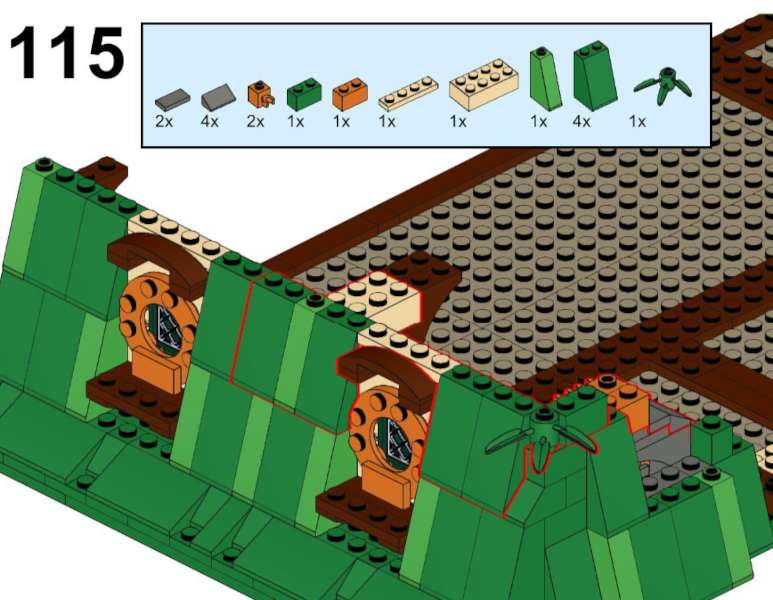
One, these instructions often add pieces without bothering to rotate the camera angle so that I could actually see where they were supposed to go! Countless times I was so frustrated by having to guess where pieces went. I skipped ahead hoping that a future step would reveal what I was supposed to have done with a previous step. In this example, where do all the gray pieces go? All the designer needed to do was rotate the camera around so that I could see the oven.
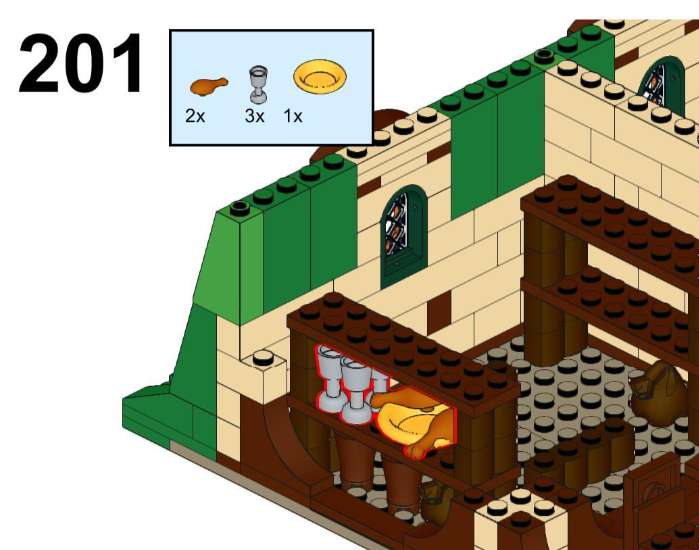
Two, these instructions often failed to build things in the right order. As one example, they built the shelves in the pantry and then came back later to put food items on the shelves. Once the shelves were completed, however, it was impossible to put some of these things on them, requiring me to backtrack and disassemble the shelves. Three, these instructions failed to build pieces in a manner that strengthened the design. When connecting two large base pieces together, they often laid foundational pieces in a manner that didn’t bother to cross the pieces and thus did not reinforce them. A small change in location would have resulted in a stronger design.
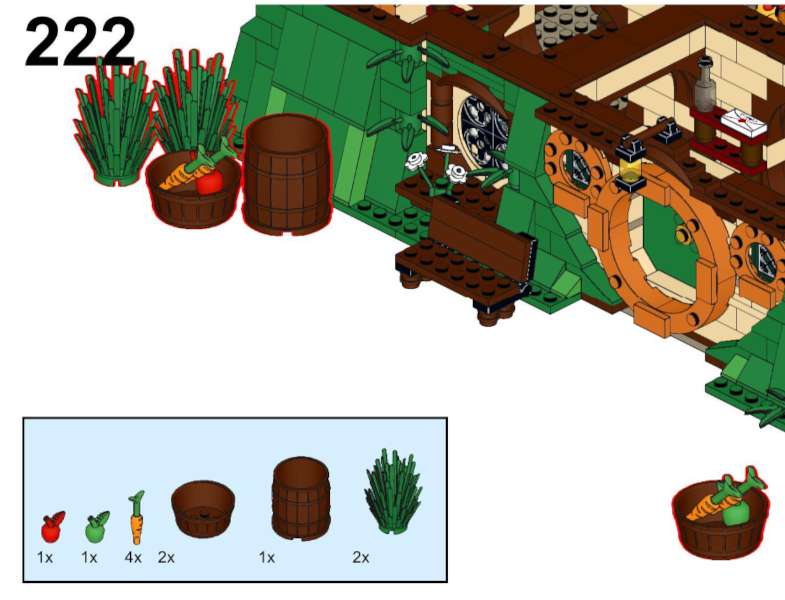
Four, these instructions left pieces floating in midair. Instead of waiting to add a piece later, once there was something to actually build on, they added it too soon, leaving them unconnected to the rest of the design.
There are a couple things to keep in mind about these instructions. One, Webrick is not the creator of these instructions, nor are they responsible for it. The instructions come from the designer. Two, the designer of this set either does have the instruction-building tools that a company like LEGO has, or he doesn’t have the skills or the patience to build the instructions correctly. When you buy a set from Webrick, it’s a bit of a risk, because you have no idea if the instructions will be great or terrible. For Bag End, I think I was able to figure out most of where things should go (still not sure about the bedroom) but when that failed I just built something kind of close (the tree on the roof is definitely not correct).
By the way, Webrick pointed out that it is possible to purchase these instructions separately from Rebrickable.
Setup
Webrick does not package or sort the bricks in any order. This means that I had to set out and sort all the pieces before building in order to start finding the ones that I want, a huge hassle that makes building so much slower. Webrick does not include a brick separator.
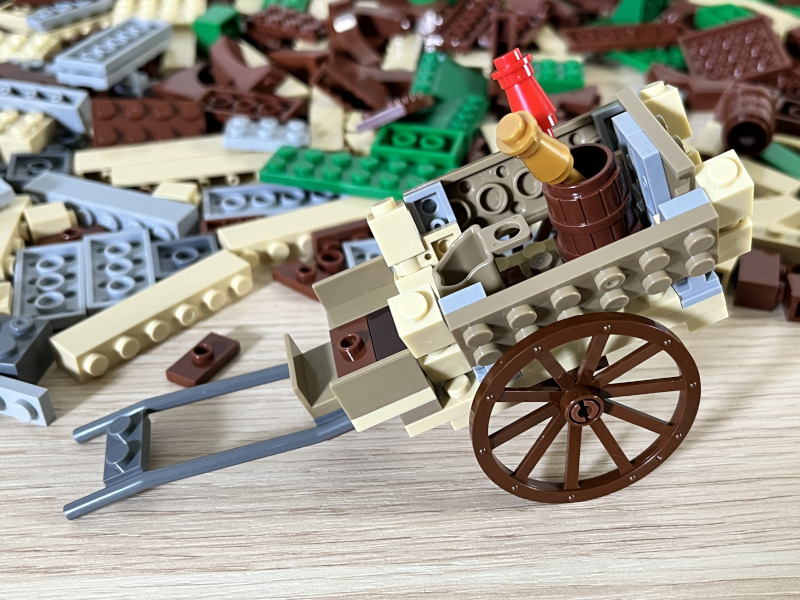
The first step in the process was building Gandalf’s cart. This is nearly identical to the original set from LEGO, which I have, though the fireworks are slightly different; Webrick failed to include a horse.
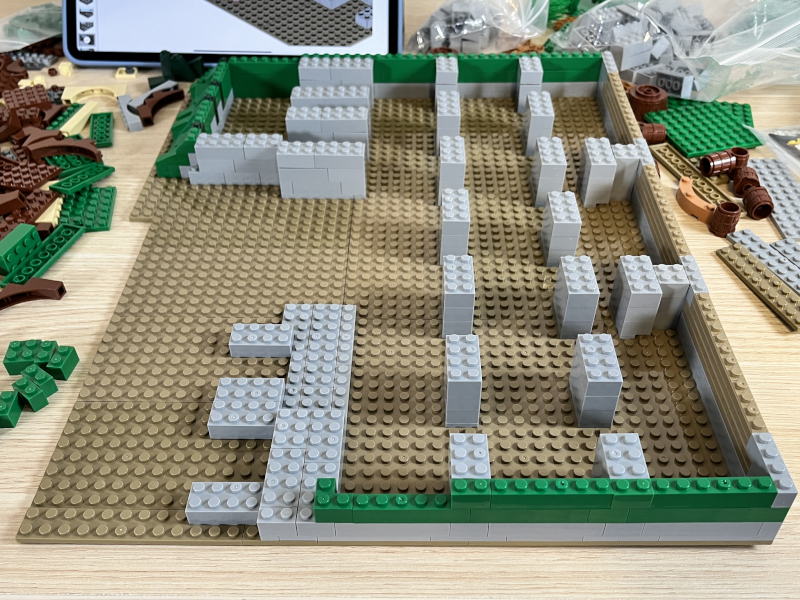
The second step was to build the base, which includes the front lawn and the foundations of the hobbit-hole. This began by connecting together several of these large, flat beige pieces, the ones that were pretty warped. You can still see that the bottom right corner piece is raised up into the air, even with the extra brick attached to it. Eventually, this problem went away as the sheer weight of the bricks pressed it down flat.
This picture also reveals (just barely) how I displayed the instructions. I loaded the PDF file onto my iPad Pro and propped it up where I was building. On the one hand, it’s inconvenient to find my iPad when I wanted to build the set; on the other hand, it’s nice to be able to zoom in when it’s hard to see the piece that I was using.
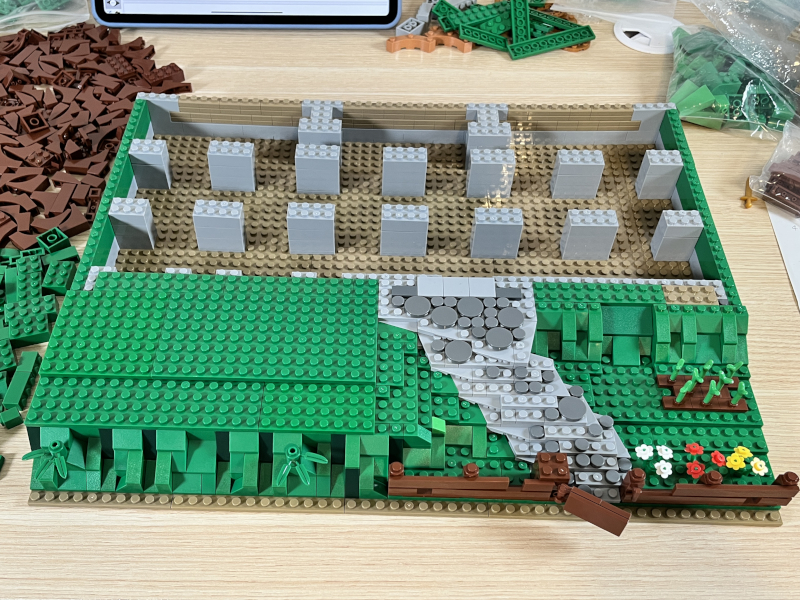
I then built out the front lawn, the steps, the fence, and a small garden. The designer did a fabulous job with this, layering things smoothly to build a gradual rise from the fence to where the front door will be. I especially like the job he did with the walkway.
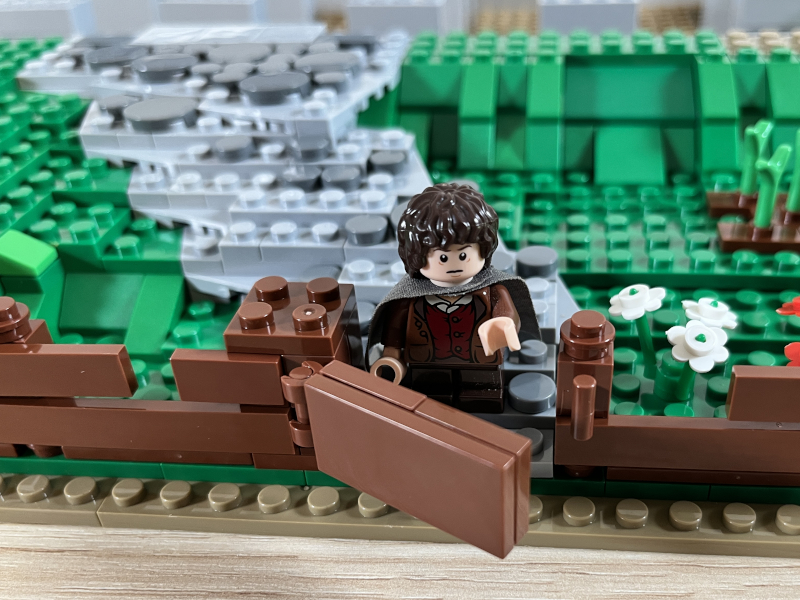
If I were to describe the vibe of this build, I would say that it’s Old School Cool. So many of the newer sets that I build work hard at being polished, ensuring that very few studs are showing in the final design; the Puppet Show is a perfect example of this. But these are LEGOs! I’m ok with studs showing. The designer of Bag End used a lot of standard pieces to build the yard that left the studs showing, and it looks good to me.
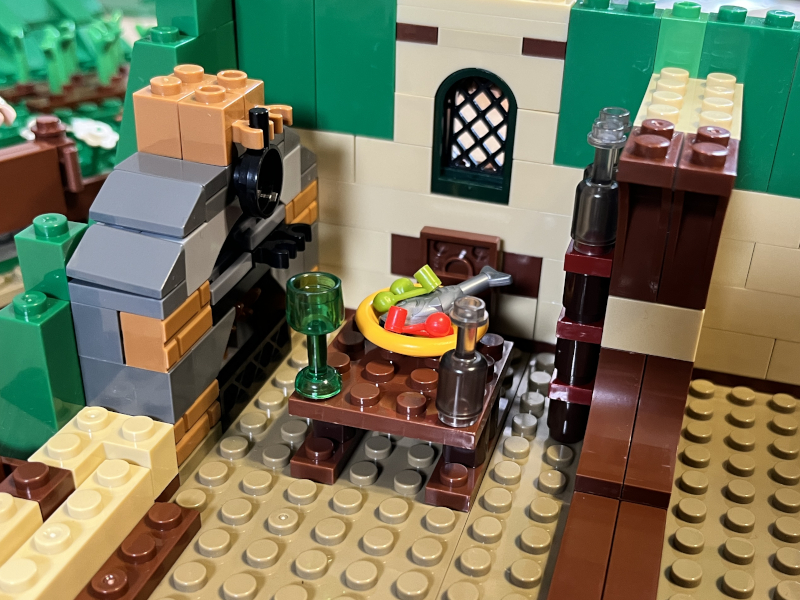
The third step is to build the hobbit-hole proper, the five rooms in Bilbo’s house. The kitchen was the first room, and it comes with an oven for cooking, a table with a meal for Bilbo, and a shelf in the corner.
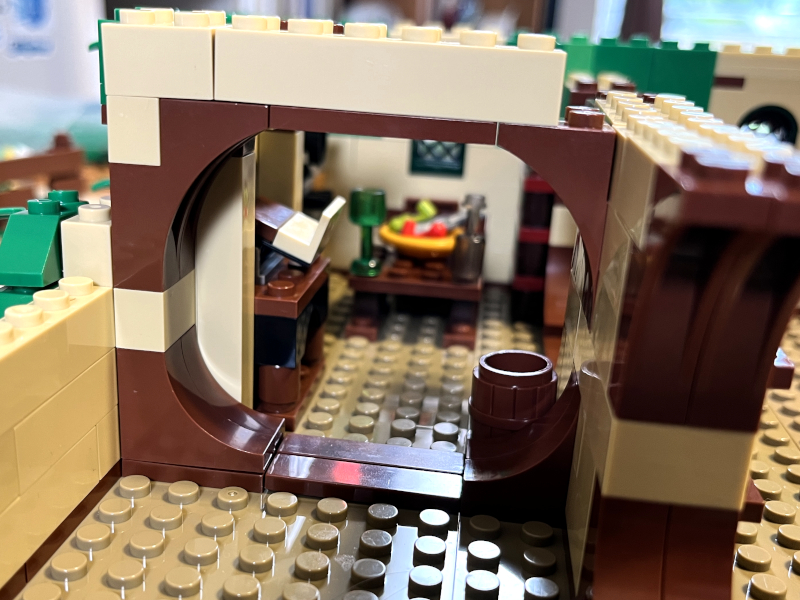
Each of the rooms are connected by these circular hallway supports that seem inspired by the movies.
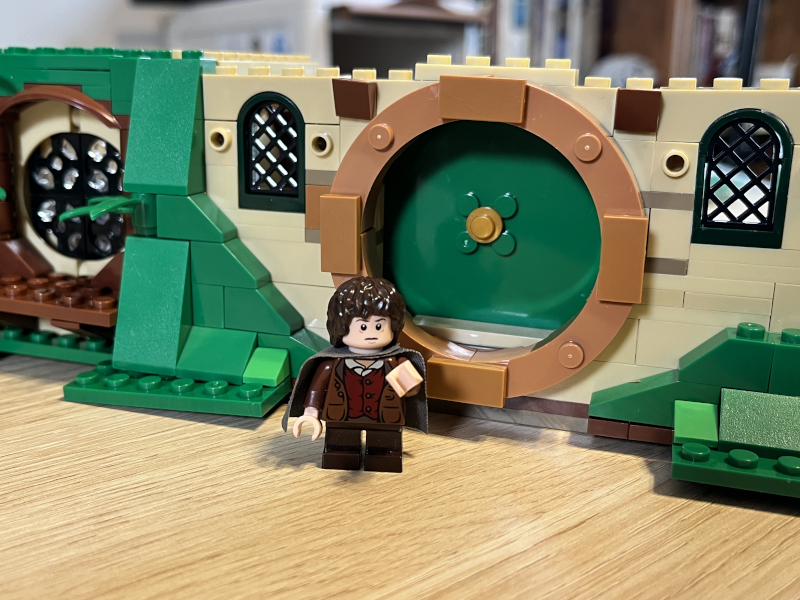
The front of the house has a large, green, round door taken from the original LEGO set. It fits the book’s description well: “It had a perfectly round door like a porthole, painted green, with a shiny yellow brass knob in the exact middle.”
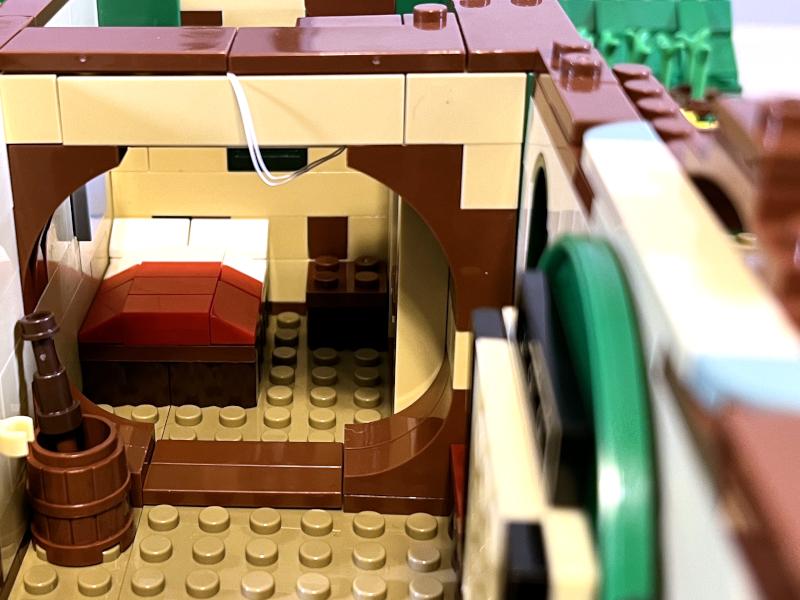
The final room in the front size of the house is Bilbo’s bedroom, a rather small affair with a brightly-colored blanket on the bed.
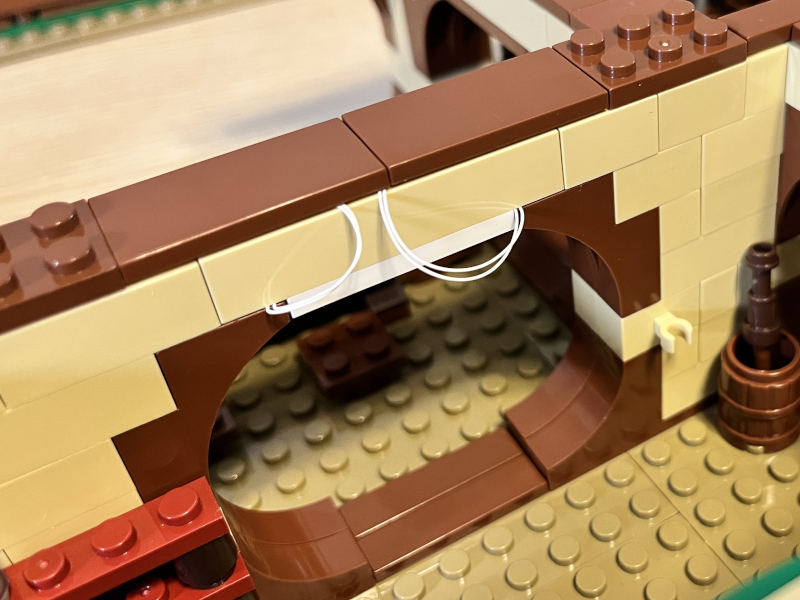
In this picture, you can see my addition to the design: lights. The white wires indicate the overhead lights that I added to four of the hallway supports and then hid using the brown pieces on top. I purchased the lights from the Brick Loot Store on Amazon. They are powered by USB, which I have connected to a Homekit-powered smart plug from Eve. Every evening Bag End lights up for a couple hours and then powers down. These LEDs are a cool white, and I wish Brick Loot had a warm white instead, which I think would look more natural.
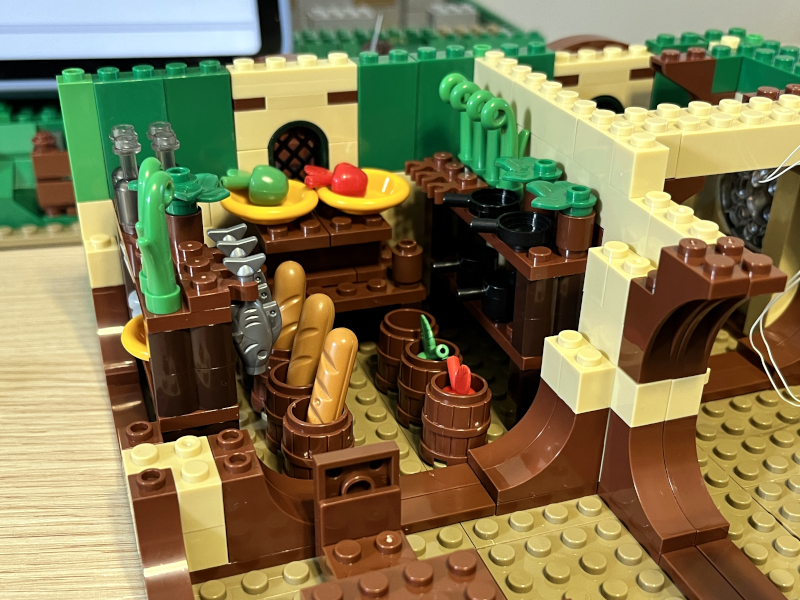
The back part of the house has a good-sized pantry with shelves, barrels, and a table stocked with food. I modified the design of this room, shoving the table against the wall and bringing the barrels out. It just made it easier to put the food into the room.
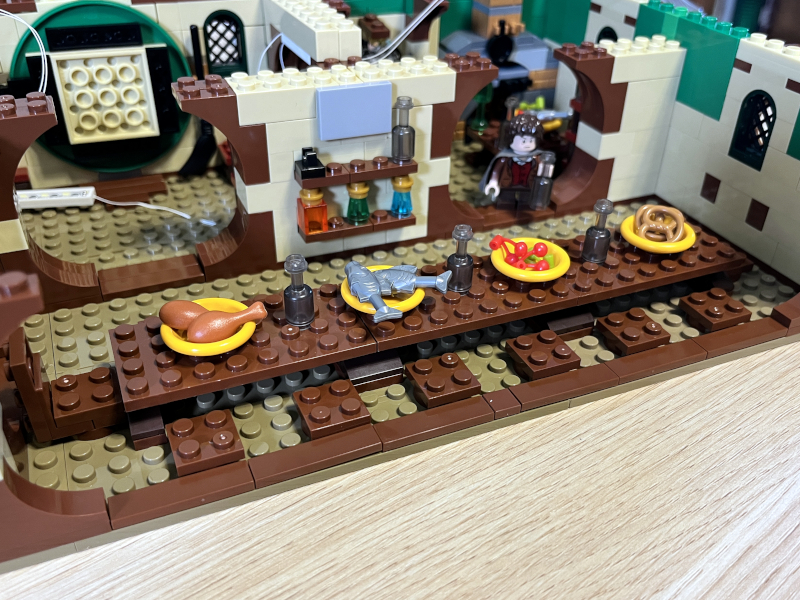
The final room is a massive dining room, large enough for thirteen dwarves to unexpectedly come over for dinner one night. If Bilbo knew company was coming, he might have set his table like so, though I expect he would have had a lot more food.
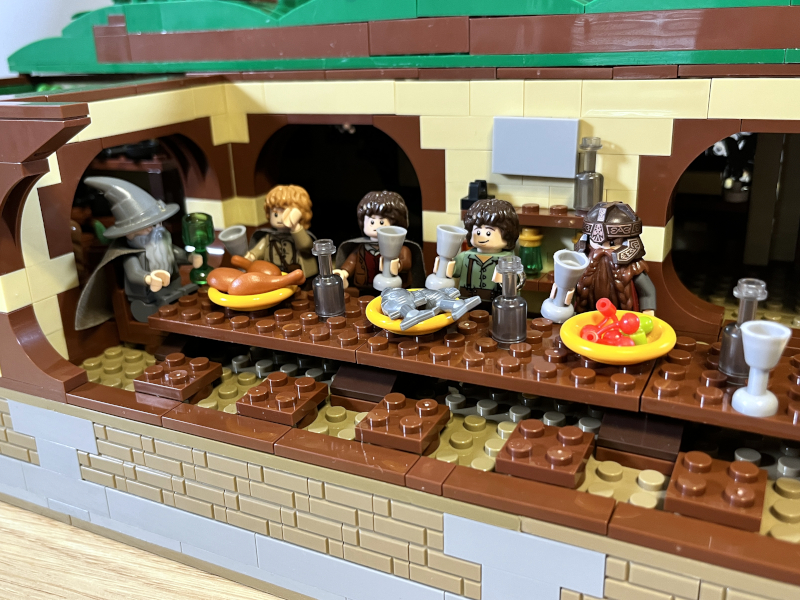
The dining room remains open-aired, even once the build was complete, making it easy to setup mini-figs and stage a party. I very much like this part of the design, as it allows kids to play with the set after it’s built.
It takes a fair amount of space to build this set. The base is 16×13 inches, and the hobbit-hole is nearly that big; plus, I need room to set out all the building blocks. Plan to use an entire desk or table for building it.
Despite asserting that a MOC Set includes all the required LEGO elements, the Bag End set is far from complete. It was missing no less than 21 pieces, mostly interior pieces like a teapot, a book, a couple swords, a couple turkeys, several carrots, and the horse. When I asked Webrick about them, they replied, “These accessories are not included in the set.” Say what?! Why not? They are part of the build. Why do they have chicken legs but not the turkeys? Why the green goblet but not the teapot? It’s so arbitrary. There’s nothing on the website that indicates that the set will be missing these pieces. Webrick told me that MOC sets are “complete sets”, and the website says that Webrick will “replace missing and damaged parts for free,” but apparently not. This is not cool. Webrick needs to either source all the pieces or put a disclaimer on their website telling people exactly what won’t be included before purchasing. If their sets are going to be more expensive then LEGOs, then they need to include everything, no exceptions.
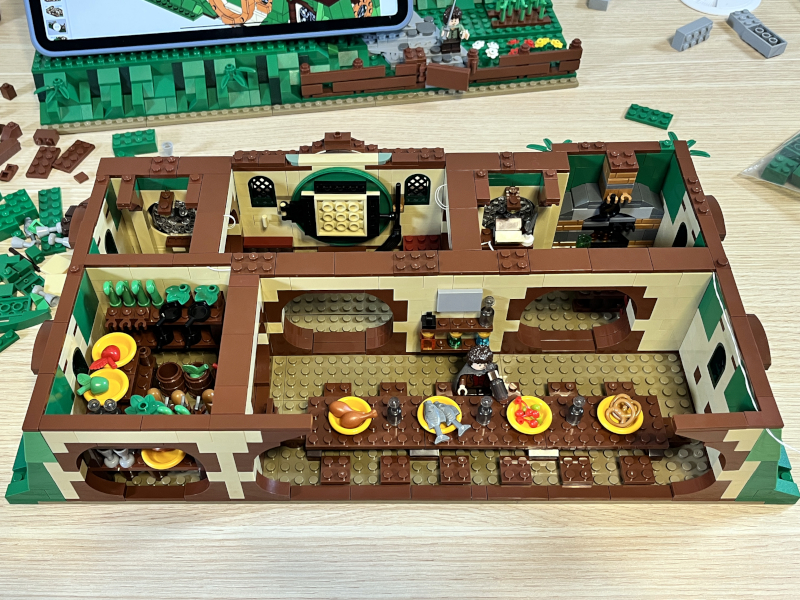
Eventually the hobbit-hole was complete!
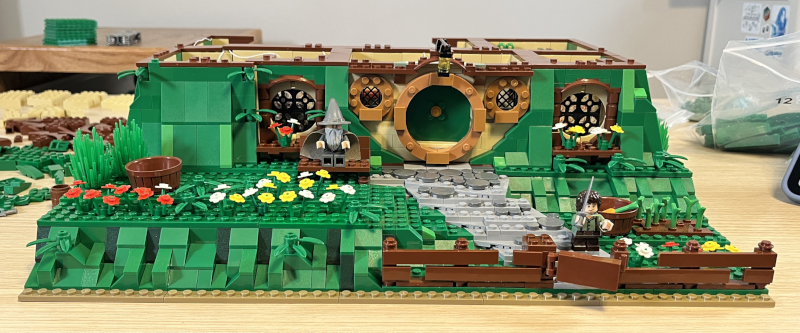
I set the hobbit-hole on top of the base and did a lot of pushing to get everything firmly connected. I think it would have been easier to build the living areas directly on top of the base, but it worked out just fine.
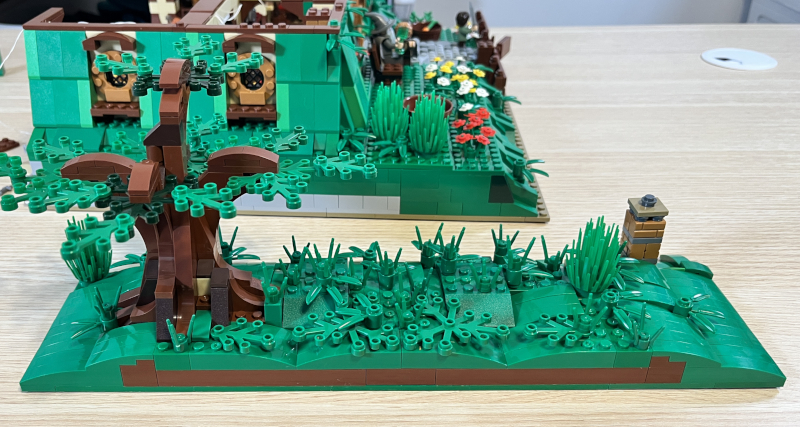
The fourth and final step was to build the detachable roof. Despite being built from smaller plates, this was a very solid piece. The tree, vegetation, and chimney are all well done.
What I like
- Bag End!
- Great design that looks good and can be played with by kids
- Good quality bricks
What I’d change
- Include all the pieces
- Work with designers to improve their instructions
- Lower the price to be competitive with other third-party suppliers
- Add some mini figs!
Final thoughts
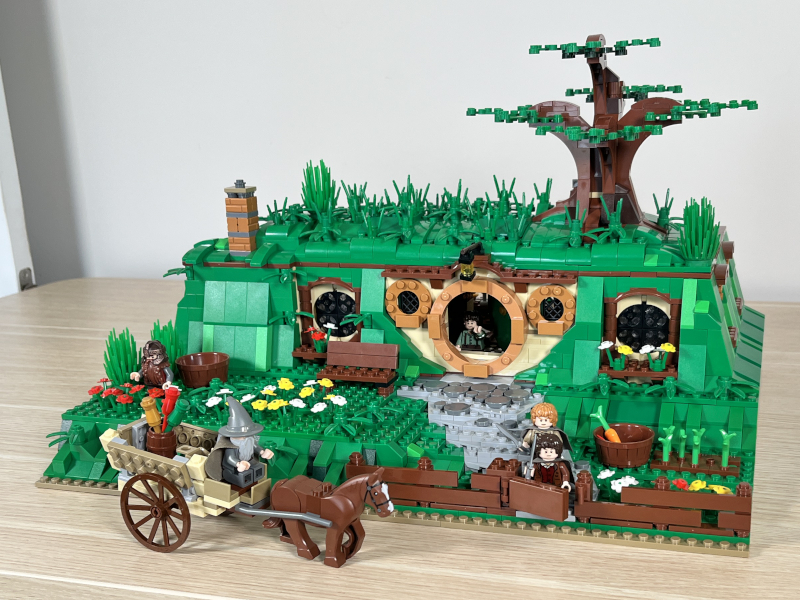
Overall, I really like Bag End. The designer has done a very nice job expanding LEGO’s original set while staying faithful to its look and feel. The result is a set that not only looks great but can be played with by kids; it also has great reuse value. The bricks are really good, a worthy addition to any kids’ collection, except for some of the large, flat ones. I am really glad to have this set sitting on my bookshelf.
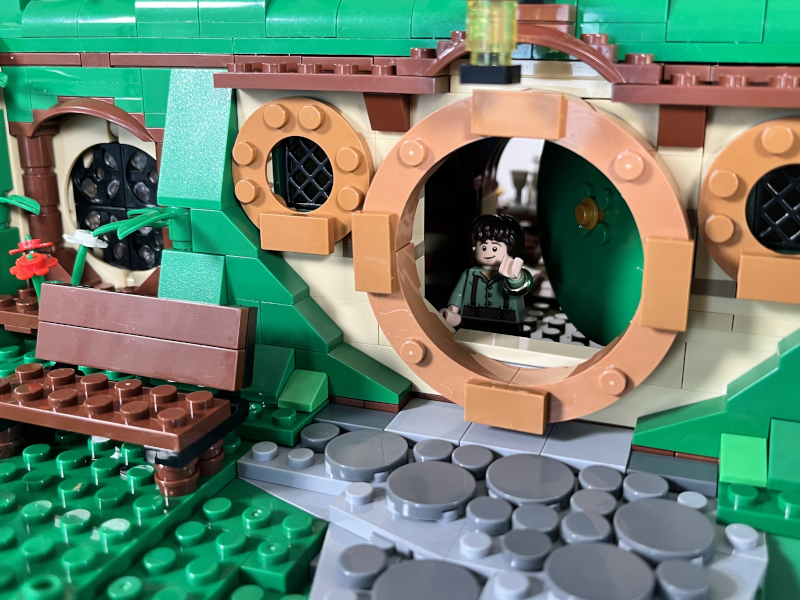
If you’re thinking about purchasing this MOC set from Webrick, there are some things that might cause you to reconsider. The instructions are terrible and caused a lot of frustration when building the set. The set is missing many of the interior accessory pieces, and there’s no way to know a priori which ones Webrick will and will not include. The price for this set is very high, more expensive than a genuine LEGO set and more than twice some other third-party sets. Finally, to get the most fun out of this set, you’ll want to acquire some mini fig characters from the Hobbit, like Biblo, Frodo, Gandalf, and the dwarves; Webrick does not sell these, so you’ll need look at places like Amazon, where prices are quite high.
Price: $240.60
Where to buy: Webrick’s online store (save 12% OFF with discount code ‘gadgeteer’ expires 12/31/2024)
Source: The sample for this review was provided by Webrick.


